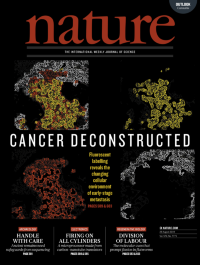Volume 572
-
No. 7771 29 August 2019
Cancer deconstructedWhen cancer cells migrate from their primary site to a secondary location in the body, they can induce the healthy cells immediately around them to create an environment — a metastatic niche — that promotes tumour formation. So far, it has proved challenging to identify the cellular processes that take place in the niche in the early stages of cancer spread. In this week’s issue, Ilaria Malanchi and her colleagues present a technique that can probe the niche’s composition. The researchers have developed a cell-penetrating fluorescent protein that is taken up by neighbouring cells. By engineering cancer cells to express this protein, the team was able to study the properties of healthy cells in a metastatic niche at early-stage metastasis. Metastatic niche analysis over time can provide a view of the changing cell composition surrounding the cancerous cells. This is illustrated on the cover by a view of metastatic breast cancer cells (yellow) that have passed the fluorescent protein to surrounding healthy cells of the niche (red), to distinguish them from non-neighbouring tissue cells (white).
Nature Outlook
-
No. 7770 22 August 2019
Burning issueThe cover shows a wildfire in Alberta, Canada, in 2016. Naturally occurring fires in boreal forests emit large amounts of carbon into the atmosphere, largely through the combustion of organic soil. But during each fire, a proportion of the soil escapes combustion and over subsequent fires this forms a store of ‘legacy’ carbon locked up in the soil. This helps to make such forests a net carbon sink, holding some 30–40% of terrestrial carbon. In this issue, Xanthe Walker, Michelle Mack and their colleagues reveal that loss of legacy carbon occurred in dry, younger forests (60 years or less) following wildfires in the Northwest Territories in Canada. The researchers’ findings suggest that with boreal wildfires increasing in size, frequency and intensity, young forests may become a net source of carbon to the atmosphere over consecutive fires and may switch the boreal carbon balance from a sink to a source.
-
No. 7769 15 August 2019
A magnetic momentIn a solid, a mobile charge carrier such as an electron, can subtly interact with its surrounding lattice environment slightly disrupting its order. This distortion is localized around the charge carrier, and the combination of the charge carrier and this distortion forms a quasiparticle called a polaron. Polarons are thought to play an important part in the description of many materials with exotic properties. In this week's issue, Christian Gross and his colleagues present the experimental observation of individual magnetic polarons, which were predicted to form in a 2D lattice featuring an antiferromagnetic background. The team imaged polarons and their inner structure using a quantum gas microscope to capture variations in the local magnetic environment. This is reflected in the cover image in which the central ball represents the polaron and the filings show the variable nature of the surrounding magnetic environment.
-
No. 7768 8 August 2019
Drawn togetherFrom flocks of birds to molecular motors, active-matter systems are made up of individual units that each consume energy from their surroundings and convert it into mechanical work. Experimental demonstrations of such systems have been widely explored for their abilities to spontaneously form patterns and generate flows. But synthetic systems usually lack the level of spatiotemporal control seen in biological systems. In this week’s issue, Tyler Ross, Matt Thomson and their colleagues show that light can be used to guide the behaviour of an engineered active-matter system, giving rise to a suite of emergent structures and properties that can be dynamically manipulated and controlled. The cover shows the microtubules that form the basis of their system. Associated with these tubules are molecular motors (orange) that walk along the tubules. These motors form dimers under light, which can then pull the tubules towards each other, allowing the researchers to control the emergent structures.
-
No. 7767 1 August 2019
Dual controlThere are two main approaches to developing artificial general intelligence. One is rooted in neuroscience, and attempts to construct circuits that closely mimic the brain. The other is grounded in computer science, and uses computers to execute machine-learning algorithms. In this week’s issue, Luping Shi and his colleagues reveal the Tianjic chip — an electronic chip that integrates the two approaches into one hybrid platform. The Tianjic chip has multiple functional cores that are readily reconfigurable, enabling it to accommodate both machine-learning algorithms and brain-inspired circuits. The researchers demonstrate the potential of this approach by incorporating one of their chips into a riderless autonomous bicycle, which can self-balance, is voice controllable and can detect and avoid obstacles, all as a result of the Tianjic chip’s simultaneous processing of versatile algorithms and models.





